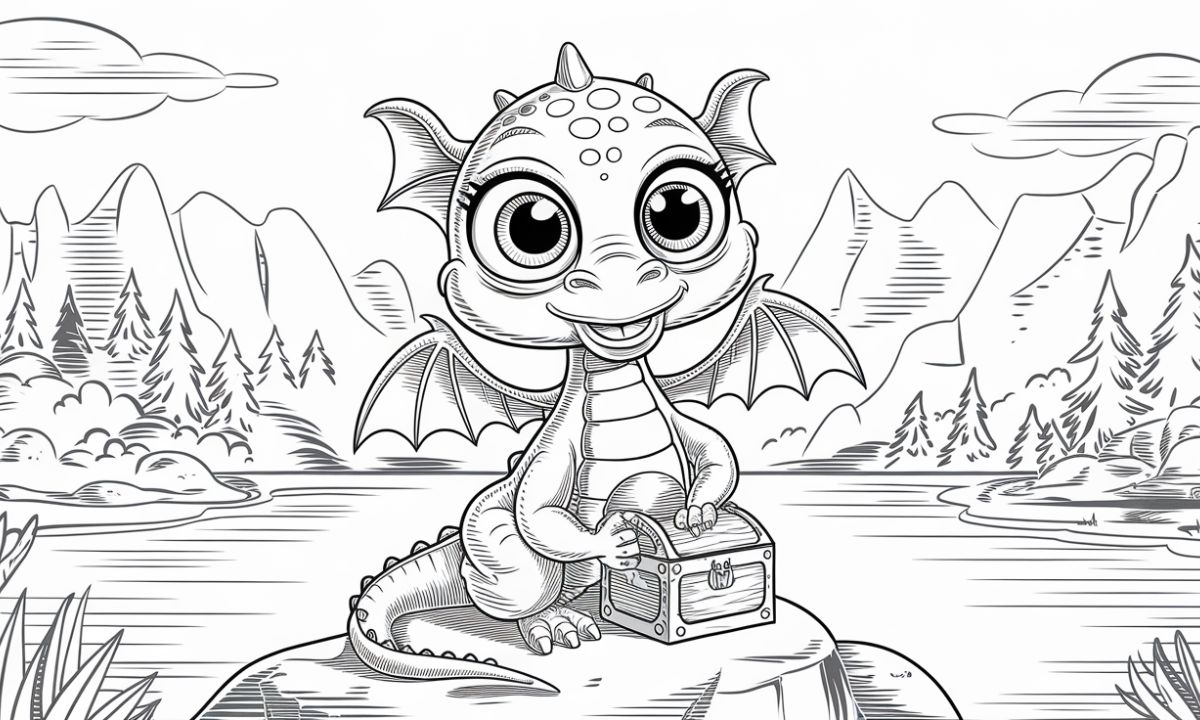Dragons captivate our imagination with their mythical power, majestic wings, and fierce yet often endearing presence. Whether you’re a seasoned artist or just starting your creative journey, drawing these fantastic creatures doesn’t have to be intimidating.
This collection of 39 cute and easy dragon drawing ideas offers something for everyone – from simple dragon heads for beginners to more detailed full-body poses for those looking to level up their fantasy art skills.
Each dragon drawing idea comes with helpful tips, techniques, and inspiration to guide you through the process. By the end of this article, you’ll have all the tools you need to create adorable, impressive dragon sketches that showcase your artistic talent.
Let’s dive into the magical world of dragon art with these accessible, fun drawing ideas!
Simple Dragon Head
A simple dragon head is the perfect starting point for anyone new to dragon drawing ideas. By focusing on just the head, you can master the essential features that make dragons recognizable without getting overwhelmed by complex body structures and wing anatomy.
Begin with basic shapes – a circle for the head and a rounded triangle for the snout. This foundation makes creating cute dragon drawing much more accessible. Add large, expressive eyes (the bigger, the cuter!) and rounded features to keep your dragon looking friendly rather than fierce.
Key tips for simple dragon heads:
- Start with a circle and build outward
- Use soft, curved lines rather than sharp angles
- Make the eyes approximately 1/3 the size of the head for maximum cuteness
- Add small, rounded horns that curve gently backward
- Include nostrils with simple curved lines
- Consider adding frills or spikes along the jawline for character
For beginners, try drawing the same simple dragon head from different angles once you’ve mastered the front view. This practice builds your understanding of dragon anatomy while keeping the exercise manageable.
Tribal Dragon Head
Tribal dragon head designs take inspiration from bold, stylized tattoo art and ancient cultural patterns. These dramatic dragon sketches rely on strong silhouettes and geometric patterns rather than realistic details, making them surprisingly easy to create despite their impressive appearance.
The tribal approach to dragon drawing ideas focuses on simplified forms with strong black lines and distinctive patterns. These designs often emphasize the dragon’s power through angular shapes and symmetrical elements.
Creating striking tribal dragon heads:
- Start with a basic dragon head outline
- Simplify the form into bold, clean shapes
- Add geometric patterns within the outline
- Use thick, confident lines for the exterior shape
- Incorporate circular, spiral, or angular motifs
- Balance positive and negative space for visual impact
“Tribal dragon designs connect us to ancient storytelling traditions where dragons were powerful symbols across many cultures.” – Traditional Art Magazine
Tribal dragon heads work beautifully as standalone art pieces and can be adapted for tattoo designs, logos, or decorative patterns. Their bold style makes them particularly effective for fantasy dragon illustrations that need to make a strong visual impact.
Lying Dragon
A lying dragon captures these mythical creatures in moments of rest, creating a peaceful contrast to their typically dynamic portrayal. This pose offers an excellent opportunity to practice drawing a dragon’s full body while maintaining the cute, approachable quality we’re aiming for in these easy dragon drawing exercises.
When creating a lying dragon, focus on the natural curve of the spine and how the body would relax against a surface. Think of how a cat or lizard might stretch out when resting – dragons often combine reptilian and mammalian features in their anatomy.
Tips for creating realistic lying dragon poses:
- Create a gentle S-curve for the spine as the foundation
- Position the limbs in relaxed, natural positions
- Allow the tail to curl comfortably
- Consider having the head resting on crossed front paws
- Add subtle details like closed or half-lidded eyes for a peaceful expression
- Use the position of the wings (folded against the body) to enhance the relaxed mood
This resting dragon sketch teaches important lessons about weight distribution and how creatures position themselves when at ease. You’ll find these principles useful for many other fantasy creature drawings as well.
Chibi Dragon
Chibi style originated in Japanese manga and anime, featuring characters with exaggerated proportions – typically oversized heads, large eyes, and tiny bodies. This adorable aesthetic is perfect for creating incredibly cute dragon drawings that appeal to dragon art enthusiasts of all ages.
The charm of chibi dragon drawing ideas lies in their extreme cuteness and simplified features. Even complex dragons become approachable when rendered in this super-deformed style.
Elements of an adorable chibi dragon:
- Head size approximately 1/2 to 1/3 of the entire body height
- Enormous, glistening eyes (often taking up half the face)
- Tiny limbs and body in proportion to the oversized head
- Minimal detailing on scales or textures
- Simple, rounded wing shapes
- Exaggerated expressions that convey emotion clearly
| Chibi Dragon Feature | Proportion Guideline | Style Tips |
| Head | 50% of total height | Perfectly round or slightly egg-shaped |
| Eyes | 40-50% of face size | Add highlights for sparkle and depth |
| Body | 25-30% of total height | Round, soft-edged shapes |
| Limbs | Short, stubby | Use simple curves, avoid detail |
| Wings | Small, simplified | Rounded edges, minimal detail |
| Tail | Short to medium length | Thick base tapering to rounded tip |
Easy chibi dragons are ideal for beginners because they forgive anatomical inaccuracies in favor of cuteness. Their simplified style also makes them perfect for quick dragon doodles and fantasy art projects when you’re short on time.
Baby Dragon Sitting
Few dragon drawing ideas capture hearts quite like a baby dragon sitting. These adorable hatchlings combine the majesty of dragons with the irresistible charm of baby animals. The sitting pose provides stability for your drawing while offering plenty of opportunities to emphasize the cute proportions of a young dragon.
When drawing baby dragons, exaggerate the proportions that signal “baby” to human brains: larger head, shorter snout, bigger eyes, and chubby limbs. These features trigger our nurturing instincts and make the dragon immediately recognizable as a juvenile.
Creating convincing baby dragon sitting poses:
- Draw the head approximately 1/3 the size of the entire body
- Create a rounded belly that appears slightly too big for the body
- Position short, chubby legs in a stable sitting position
- Add tiny wing nubs or undersized wings that suggest they’re still growing
- Include baby-like features such as rounded horns or horn buds
- Consider adding small, harmless puffs of smoke instead of flames
Baby dragon drawings often benefit from props that emphasize their small size and youthful nature – perhaps sitting next to an egg shell, holding a tiny treasure, or wearing an oversized pendant.
This dragon sketch idea teaches valuable lessons about character development through proportion and posing, skills that transfer to many other fantasy creature drawings.
Serpent Dragon
Serpent dragons draw inspiration from Eastern dragon traditions, where dragons are often portrayed as long, sinuous beings without wings. These elegant creatures offer a different aesthetic from the typical Western dragon and provide excellent practice for creating flowing, curved forms.
The key to successful serpentine dragon sketches lies in creating a sense of fluid movement through the body. Unlike the more rigid structure of Western dragons, these creatures move like water currents, with bodies that can curl and twist with mesmerizing grace.
Mastering serpentine dragon forms:
- Begin with a flowing line that creates S-curves or spiral shapes
- Keep the body diameter relatively consistent (unlike Western dragons’ barrel chests)
- Add small legs evenly spaced along the body (typically 4-5 pairs)
- Create a distinctive head with whiskers, antlers, or frills
- Use minimal wing elements or omit wings entirely
- Add simple scale patterns that follow the body’s curve
Serpent dragons make stunning fantasy dragon illustrations when arranged in circular or spiral compositions. Their flowing forms allow for creative layouts that would be difficult to achieve with bulkier dragon types.
Happy Walking Dragon
A happy walking dragon captures these mythical beasts in a moment of carefree movement, creating an instant connection with viewers. This dragon drawing idea balances dynamism with stability, making it accessible for intermediate artists looking to create more lively dragon sketches.
The walking pose introduces the challenge of creating believable weight and movement. Pay close attention to which legs are bearing weight and how the body shifts to accommodate the walking motion.
Creating dynamic walking dragon poses:
- Establish a horizontal line for the ground
- Position diagonal legs (front-right and back-left, or front-left and back-right) on the ground
- Lift the opposite legs slightly, suggesting forward movement
- Tilt the head forward slightly in the direction of movement
- Add a slight bounce to the body line
- Position the tail for counterbalance, perhaps with a happy swish
To convey happiness in your dragon’s walk, incorporate:
- A slight upward curve to the mouth
- Bright, wide-open eyes
- Perked-up ears or frills
- A high-carried chest
- Perhaps a small flame or smoke puff of contentment
Happy walking dragons work wonderfully in children’s book illustrations or as cheerful fantasy art for any dragon enthusiast’s collection.
Cute Little Dragon
Small size equals big charm when it comes to cute dragon drawing ideas. Little dragons pack all the magnificence of their larger counterparts into an adorable, pocket-sized package that’s irresistible to draw and delightful to behold.
The key to creating effective tiny dragons lies in simplifying details while maintaining recognizable dragon features. Small curved horns, miniature wings, and an expressive face help establish the creature as a dragon despite its diminutive size.
Maximizing cuteness in little dragon drawings:
- Keep proportions slightly chubby for maximum appeal
- Use large, expressive eyes (approximately 1/3 of head size)
- Create small, rounded horns and ear frills
- Design wings that are proportionally appropriate (not too large)
- Add tiny claws that look more cute than dangerous
- Consider placing next to normal-sized objects for scale contrast
“The smaller the dragon, the bigger its personality should be in your drawing. Tiny dragons need expressions that speak volumes!” – Fantasy Illustration Guidebook
Little dragons make perfect subjects for whimsical scenarios – perhaps perched on a mushroom, riding a mouse, or curled up in a teacup. These imaginative contexts enhance their charm while providing creative storytelling opportunities through your dragon art.
Sleeping Dragon
Sleeping dragons provide wonderful opportunities to practice creating peaceful poses while maintaining the recognizable features of these mythical creatures. A dozing dragon shows these powerful beings at their most vulnerable, creating an emotionally engaging contrast that viewers find appealing.
Sleeping poses also allow you to practice foreshortening and overlapping forms as the dragon curls up in restful positions. These valuable skills transfer to many other drawing challenges beyond dragon art.
Keys to convincing sleeping dragon drawings:
- Create a curled or nestled body position that conveys comfort
- Draw the head tucked close to the body, perhaps under a wing
- Show relaxed muscles rather than tension
- Consider half-closed eyes or completely closed eyes with visible eyelids
- Add gentle breathing indicators like a slightly open mouth or expanded ribcage
- Include environmental elements like a bed of treasure, cloud, or forest nest
For extra charm, consider adding small details like:
- Tiny puffs of smoke with each breath
- A slight smile on the sleeping face
- A stuffed animal or treasure clutched while sleeping
- Dream bubbles showing what the dragon might be dreaming about
Sleeping dragon sketches teach important lessons about how to convey weight and relaxation through line work and positioning – valuable skills for any artist’s development.
Growling Dragon
A growling dragon presents the challenge of creating a pose that conveys power and intensity while still maintaining the cute, approachable aesthetic we’re aiming for in these dragon drawing ideas. The secret lies in balancing fearsome elements with playful or exaggerated features.
Think of a growling puppy or kitten – their attempt at ferocity often comes across as endearing rather than frightening. Apply this same principle to your dragon drawings by incorporating elements that soften the fierce expression.
Creating adorable growling dragons:
- Exaggerate the opened mouth with a prominent underbite
- Show small, rounded teeth rather than razor-sharp fangs
- Create large, expressive eyes that contradict the fierce pose
- Position the body in a playful “pounce” stance
- Add smoke puffs instead of full flames
- Include details like a wagging tail that undermines the serious growl
This type of dragon sketch teaches valuable lessons about conveying conflicting emotions in a single character – a skill useful across many character design contexts.
Dragon Sketch
Quick, loose dragon sketches serve as both practice exercises and artistic expressions in their own right. These rougher drawings capture the energy and spirit of dragons without getting bogged down in details, making them perfect for building confidence and exploring new dragon drawing ideas.
Sketching allows you to focus on the essential elements that make a dragon recognizable – the general shape of the head, the distinctive silhouette, the proportions of wings to body. This approach frees you to experiment with different poses and dragon types without committing to a highly detailed drawing.
Tips for expressive dragon sketches:
- Use quick, confident strokes rather than careful, precise lines
- Focus on capturing movement and energy over perfect anatomy
- Establish major forms first (head, body, wings, tail) before adding any details
- Vary line weight to add depth and emphasis
- Allow some lines to remain rough or incomplete
- Concentrate on the character and mood rather than technical precision
Dragon sketches serve as excellent warm-up exercises before attempting more detailed dragon art. They also help you generate new ideas that you might develop into more refined dragon illustrations later.
Dragon in a Teacup
The charming contrast between a fierce mythical creature and a delicate teacup creates an instantly appealing image. This dragon drawing idea plays with scale and context to create whimsical, shareable art that showcases both your technical skills and creative imagination.
The teacup dragon concept works particularly well for cute dragon drawing projects because it establishes the dragon as tiny and therefore inherently less threatening. This context allows you to focus on creating an adorable character while also practicing drawing curved surfaces and reflective elements.
Creating convincing teacup dragons:
- Draw the teacup first, establishing proper elliptical perspective
- Size the dragon appropriately to fit comfortably in the cup
- Show interaction between dragon and cup (peeking over rim, tail hanging over edge)
- Add tea elements (liquid, steam) that the dragon might be playing with
- Consider the dragon’s personality – is it bathing? Drinking? Just lounging?
- Use the teacup’s pattern and color to complement your dragon design
This concept teaches valuable lessons about scale, context, and how environment helps tell a character’s story – principles that apply across all forms of illustration.
Sleeping Dragon on a Cloud
Dragons sleeping on clouds combine whimsy with tranquility, creating a dreamy, peaceful image that’s perfect for fantasy art collections. This concept challenges you to create two distinct textures – the solid form of the dragon and the ephemeral fluffiness of clouds.
Cloud dragons tap into our associations with the sky, dreams, and gentle fantasy worlds. They make perfect subjects for nursery art, children’s book illustrations, or any project needing a touch of magical serenity.
Tips for cloud-dwelling dragons:
- Create cloud forms using clusters of rounded shapes with soft, undefined edges
- Position the dragon so it appears to sink slightly into the cloud’s surface
- Use the cloud’s shape to complement the dragon’s sleeping pose
- Consider adding sky elements like stars, moons, or subtle color gradients
- Show the dragon in complete relaxation, perhaps with a gentle smile
- Add small details like rising/falling with breath or tiny dream bubbles
This dragon drawing idea offers excellent practice in creating contrast between different textures and densities while maintaining a cohesive, magical scene.
Dragon Fairy
Dragon fairies blend two beloved fantasy creatures to create something uniquely charming. These hybrid beings typically feature dragon-like features (scales, wings, tails) combined with fairy proportions and magical elements. They offer exciting possibilities for creative expression while remaining accessible to draw.
The key to successful dragon fairy designs lies in thoughtful integration of features from both creatures. Rather than simply attaching fairy wings to a dragon or adding scales to a fairy, consider how these beings might have evolved as their own distinct species.
Elements of compelling dragon fairy designs:
- Slender, fairy-like body proportions with subtle dragon scales
- Wings that combine insect transparency with dragon structure
- Delicate facial features with slight dragon elements (pointed ears, reptilian eyes)
- Long, slender dragon tail that balances the composition
- Small horns or antennae that complement the overall design
- Magical elements like glowing patterns, fairy dust, or tiny flames
Dragon fairies make wonderful subjects for colorful fantasy dragon illustrations, offering opportunities to experiment with luminous effects and delicate detailing.
Happy Flying Dragon
Few dragon drawing ideas capture the joy and freedom of these mythical creatures quite like a happy flying dragon. This pose celebrates dragons in their element – soaring through the skies with expressions of pure delight.
Creating dynamic flying poses can be challenging, but focusing on the excitement and happiness of the dragon makes the technical aspects more approachable. The emotion of the scene helps carry the image even if the anatomy isn’t perfect.
Keys to joyful flying dragon art:
- Position the body in a gentle curve that suggests movement through air
- Extend the wings fully in a gliding position or show them mid-flap
- Create an unmistakably happy expression (wide eyes, open mouth “smile”)
- Use the tail as a rudder, perhaps curving it upward for extra dynamism
- Add wind effects like streaming mane or frills
- Consider cloud elements or speed lines to enhance the sensation of flight
This dragon sketch concept teaches valuable lessons about conveying emotion through body language and facial expression – skills that transfer to all character-based art.
Curled Sleeping Dragon
A dragon curled into a tight spiral creates a visually satisfying, geometrically pleasing image that’s surprisingly easy to draw despite its impressive appearance. This dragon drawing idea focuses on creating a sense of comfort and security through the protective sleeping position.
The circular composition of a curled dragon creates a natural focal point and works well in many contexts – from decorative art to tattoo designs. The pose also offers natural opportunities to practice drawing a dragon from unusual angles as the body wraps around itself.
Creating perfect spiral dragon poses:
- Start with a simple spiral line as your guide
- Build the body around this spiral, gradually thickening toward the shoulders
- Position the head resting on or near the outermost curve
- Tuck the legs close to the body or underneath
- Wind the tail toward the center of the spiral
- Add wings folded flat against the body or draped over like a blanket
For extra appeal, consider adding tiny details that enhance the peaceful mood:
- A little smile on the sleeping face
- The tip of the tail curled around the nose
- One eye slightly open in a sleepy peek
- Small puffs of smoke or steam with each breath
This dragon sketch design teaches valuable lessons about creating balanced compositions and conveying the weight of a resting creature.
Chubby Dragon with a Big Belly
Chubby dragons with prominent bellies bring instant charm to any dragon drawing collection. These rotund reptiles subvert expectations of fearsome, sleek dragons, creating instead an endearing character that viewers immediately want to befriend.
The key to successful chubby dragon drawings lies in thoughtful exaggeration. The rounded belly should look natural and comfortable rather than awkward or strained. Think of happy, well-fed creatures whose bodies express their contentment.
Tips for creating adorable chubby dragons:
- Create a pronounced curve for the belly that extends well below the line of the back
- Position the legs wider apart to accommodate the larger body
- Add small, fat rolls or creases where appropriate
- Keep the head proportionally smaller to emphasize the body roundness
- Consider a satisfied expression that matches the well-fed appearance
- Include details like a loosened belt, stretched clothing, or a tiny food item
Chubby dragons work wonderfully in humorous contexts – perhaps guarding a cookie jar instead of treasure, or unable to fly because of their recent feast. These scenarios add storytelling elements that enhance the drawing’s appeal.
Sleek Dragon with Pink Wings
Colorful wings provide wonderful opportunities to add personality and visual interest to your dragon sketches. A sleek dragon with vibrant pink wings creates an eye-catching contrast between the streamlined body and the bold wing color, resulting in a memorable character design.
This dragon drawing idea challenges you to balance different visual elements – the elegant body structure and the attention-grabbing wing color. The contrast creates visual interest while the cohesive design ensures the dragon still feels like a unified character.
Creating compelling colored-wing dragons:
- Design a streamlined, athletic body that contrasts with the decorative wings
- Use the pink (or other colors) strategically to draw attention to the wing structure
- Consider gradient effects or patterns within the wing membranes
- Ensure the color choice reflects the dragon’s personality
- Balance the bold wing color with complementary colors elsewhere in the design
- Add subtle details like translucency or veining in the wing membranes
Color psychology can enhance your dragon designs – pink might suggest playfulness, affection, or youth, while blues might convey calm wisdom and greens could suggest nature connections.
Tall and Cute Dragon
Tall, lanky dragons offer a refreshing alternative to both bulky Western dragons and serpentine Eastern dragons. These elongated creatures maintain their cuteness through facial expressions and proportions while their unusual height creates visual interest and character distinction.
The challenge with tall dragon designs lies in maintaining balance and believability. Despite their height, these dragons should still look capable of movement and flight rather than awkwardly stretched.
Keys to successful tall dragon designs:
- Extend the neck and legs while keeping the head and body proportionally smaller
- Create a graceful silhouette despite the unusual proportions
- Use the long tail as a counterbalance to the extended neck
- Design wings that complement the tall form without overwhelming it
- Add personality through facial expression and posture
- Consider giving the dragon a slight stoop or bend to suggest personality
Tall dragons work particularly well in compositions where their height can interact with the environment – perhaps peeking into second-story windows or stretching to reach high branches.
Dragon with Open Wings
Dragons with fully extended wings capture these creatures in their most majestic form. This dragon drawing idea focuses on creating impressive wingspan while maintaining the cute aesthetic we’re aiming for in these accessible dragon sketches.
Wing structure can seem intimidating, but breaking it down into simple shapes makes it manageable even for beginners. The basic structure resembles a modified hand – a main “arm” bone with “finger” bones extending outward to support the wing membrane.
Tips for impressive dragon wings:
- Start with a simple bat-wing structure (central arm bone with finger-like extensions)
- Create a membrane that stretches between these supports
- Show realistic tension in the membrane – tighter near the body, slightly scalloped between supports
- Consider the wing’s position relative to the body for balance
- Add texture with simple vein patterns or color variations
- Ensure the wings look proportional to the body size
| Wing Part | Structure | Drawing Approach |
| Main arm | Single thick bone | Strong curved line from shoulder |
| “Fingers” | 3-5 extending supports | Gradually decreasing in length |
| Membrane | Skin stretched between supports | Curved lines between supports |
| Wing joint | Connection to shoulder | Thickened area with detail |
| Wing tip | Pointed or rounded end | Often has a claw or decorative element |
This dragon sketch concept teaches valuable lessons about anatomy, balance, and creating impressive features while maintaining an accessible drawing approach.
Flying Serpentine Dragon
Flying serpentine dragons combine the sinuous grace of Eastern dragons with the aerial majesty traditionally associated with Western dragons. These elegant creatures create S-curves through the air, offering exciting opportunities for dynamic compositions and flowing lines.
The key to effective serpentine flying dragons lies in creating a sense of weightless movement. Unlike bulkier dragons that might seem to power through the air, these creatures appear to swim through the sky with undulating movements.
Creating dynamic serpentine flight:
- Begin with a flowing S-curve or wave pattern as your main body line
- Add small legs tucked close to the body to streamline for flight
- Position the head leading the movement, often with an upward gaze
- Create minimal, fin-like wings or decorative flight features
- Use the tail to continue and complete the flowing line
- Add movement lines or cloud elements to enhance the sense of motion
This dragon drawing idea challenges you to convey movement through line quality and positioning. Practice varying your line weight – thicker in the foreground, thinner as body parts recede – to enhance the three-dimensional quality of your flying dragon.
Adorable Baby Dragon
Baby dragons tap into our natural affinity for infant creatures, making them some of the most popular subjects for cute dragon drawing projects. These hatchlings combine vulnerability with the promise of future power, creating an irresistible contrast that appeals to our protective instincts.
When drawing baby dragons, exaggerate the features we associate with infancy across species – proportionally larger heads, shorter snouts, bigger eyes, and chubbier bodies. These universal “baby signals” ensure viewers immediately recognize your dragon as a youngster.
Characteristics of convincing baby dragons:
- Head approximately 1/3 of total body size
- Eyes positioned lower on the face than adult dragons
- Stubby horns or just horn “nubs”
- Short, chubby limbs with less defined muscles
- Oversized feet that suggest “growing into them”
- Wings that appear too small for flight
- Round belly and generally softer features
For extra appeal, consider showing baby dragons in typical infant activities – attempting their first flame (perhaps producing only a hiccup of smoke), playing with their tails, or interacting with objects too large for them.
Little Standing Dragon
A small dragon in a confident standing pose creates an immediately endearing contrast between size and attitude. This dragon drawing idea focuses on creating a stable, balanced pose that conveys personality despite the character’s diminutive stature.
Standing poses require attention to weight distribution and balance. Even in stylized cute dragon drawings, a grounded stance helps create a sense of believability that enhances the character’s appeal.
Creating balanced standing dragon poses:
- Position feet firmly on a ground line for stability
- Create a slight contrapposto (weight shift) for natural appearance
- Align the shoulders over the supporting hip/leg
- Use the tail as a counterbalance if necessary
- Add small details like raised claws or toe pads that contact the ground
- Consider the character’s personality in the stance (proud, shy, curious)
Little standing dragons work wonderfully as character studies, allowing you to express personality through posture before adding any background elements or context.
Flying Baby Dragon
Baby dragons attempting their first flights create instantly charming scenes full of personality and storytelling potential. These dragon drawing ideas combine the inherent cuteness of baby creatures with the dynamic possibilities of flight attempts.
The key to endearing flying baby dragons lies in suggesting effort and determination rather than effortless mastery. Small wings working overtime, concentrated expressions, and not-quite-perfect body positions all contribute to the heartwarming impression of a youngster learning a new skill.
Tips for adorable first-flight dragons:
- Draw wings that appear slightly too small for effective flight
- Show intense concentration in the facial expression
- Position the body in a not-quite-aerodynamic way
- Add motion lines that suggest flapping effort
- Consider including elements showing slight instability (tilted horizon, asymmetrical wing positions)
- Use the environment to enhance the story (launching from a nest, hovering just above ground)
This dragon sketch concept teaches valuable lessons about conveying effort and determination through posture and expression – characteristics that add depth to any character design.
Simple Dragon
Sometimes the most appealing dragon drawing ideas are the simplest. A basic dragon design stripped down to its essential elements offers beginners an accessible entry point while still capturing the magic and appeal of these mythical creatures.
Simple dragons focus on the most recognizable dragon features – distinctive head shape, wings, tail, and general body form – while minimizing complex details like scales, muscles, and ornate horns.
Creating effective simple dragons:
- Use basic geometric shapes as building blocks (circles, ovals, triangles)
- Focus on silhouette – the outline should be instantly recognizable as “dragon”
- Limit details to those that define the character (eyes, basic horns, simple wings)
- Use clean, confident lines rather than sketchy, uncertain ones
- Add minimal texture indicators rather than detailed patterns
- Let personality shine through basic posing and expression
“The simplest dragon drawings often have the strongest visual impact. When you remove unnecessary details, what remains speaks more clearly.” – Character Design Workshop
Simple dragons serve as excellent foundation studies before attempting more complex dragon art. They also work well for projects requiring bold, recognizable designs like logos, badges, or simplified illustrations.
Flying Dragon Looking Up
A dragon soaring with its gaze turned skyward creates a sense of aspiration and freedom that resonates with viewers. This dragon drawing idea captures a moment of joy and possibility, resulting in an uplifting piece of fantasy art.
The upward gaze presents interesting challenges for facial structure and neck positioning. The foreshortened view of the underside of the jaw and neck requires careful attention to maintain believable anatomy while keeping the drawing process accessible.
Keys to effective upward-gazing dragons:
- Position the head with the chin lifted, exposing the underside of the jaw
- Create a curved neck that supports the upward head position
- Align the body to complement the upward movement
- Extend the wings in a position that supports ascending flight
- Use the tail as a rudder, perhaps curving it to suggest directional control
- Add cloud elements or sky indicators to enhance the upward context
This perspective teaches valuable lessons about viewing angles and foreshortening – skills that transfer to many other drawing challenges beyond dragon art.
Sleeping Dragon
A sleeping dragon presents a beautiful opportunity to explore the peaceful side of these normally powerful and dynamic creatures. When drawing a dragon in slumber, you can create a compelling contrast between their inherent power and their current vulnerability – a juxtaposition that immediately draws viewers in.
Start with the body position. Sleeping dragons often curl up much like cats or dogs, with their bodies forming a gentle C-shape or spiral. This natural resting pose not only looks believable but also creates an aesthetically pleasing composition. Position the head tucked close to the body, perhaps resting on crossed front paws or nestled under a wing. This protective sleeping position feels authentic and enhances the dragon’s appeal.
Tips for creating a convincing sleeping dragon:
- Pay attention to muscle relaxation – a sleeping body should look soft and heavy rather than tense
- Consider having the eyes fully closed or slightly cracked open for a drowsy effect
- Show the dragon’s weight sinking into whatever surface they’re resting on
- Add small details like gentle breathing indicated by a slightly expanded ribcage
- Position wings folded neatly against the body rather than extended
For extra charm, include small details that enhance the peaceful mood. Perhaps add tiny puffs of smoke rising with each breath, a slight smile suggesting pleasant dreams, or even a small treasure clutched close like a child’s teddy bear. These touches add personality and narrative to your dragon drawing.
The sleeping pose also offers excellent practice in foreshortening and overlapping forms. As the dragon curls up, certain body parts will naturally overlap others, creating interesting compositional challenges. This valuable practice develops skills that transfer to many other drawing subjects.
Consider the environment around your sleeping dragon too. Are they nestled in a cave full of treasure? Dozing on a mountainside? Napping on a cloud? The setting can enhance the mood and tell viewers more about your dragon’s personality and habits.
Whether you’re creating a fierce guardian taking a well-deserved rest or an adorable baby dragon enjoying a nap, the sleeping dragon drawing idea offers a perfect balance of technical practice and heartwarming appeal.
Standing Dragon
A confident standing dragon serves as an excellent study in balance, proportion, and character development. This fundamental pose establishes your dragon as a grounded, substantial presence rather than just a fantastical concept.
The standing pose might seem simple, but it requires careful attention to weight distribution and anatomical structure. Even in cute, stylized dragon drawing ideas, a believable stance helps viewers connect with the character.
Creating compelling standing dragons:
- Establish a clear ground line for stability
- Position the feet in a balanced, natural stance
- Align the body mass over the supporting limbs
- Show weight and substance through subtle details (slight compression where feet meet ground)
- Consider the dragon’s personality in its posture (proud, alert, relaxed)
- Use the tail position to enhance balance and character expression
Standing dragons provide excellent practice for understanding creature anatomy and weight distribution – foundational skills for all character artists.
Sitting Dragon with Open Wings
A sitting dragon displaying open wings creates a striking contrast between the grounded stability of the seated position and the majestic spread of extended wings. This dragon drawing idea combines approachability with impressive display features.
The challenge lies in creating a believable sitting pose while maintaining proper wing anatomy. The wings should connect naturally to the shoulderblades while the body remains firmly seated.
Tips for seated dragons with spread wings:
- Create a stable sitting position first (weight on haunches, front paws on ground)
- Position wings as extending from shoulderblades, behind the front legs
- Show appropriate wing joints that allow for the spread position
- Consider gravity’s effect on the extended wing membranes
- Balance the composition with appropriate tail positioning
- Add personality through facial expression that complements the display posture
This combination pose teaches valuable lessons about integrating different body positions into a cohesive whole – skills useful across many drawing disciplines.
Cute Sitting Dragon
A dragon in an adorable sitting pose creates an instantly approachable character that viewers want to befriend. This popular dragon drawing idea focuses on creating a comfortable, natural sitting position that enhances the dragon’s cute characteristics.
The key to charming sitting dragons lies in finding the balance between realistic animal sitting positions and anthropomorphic characteristics that increase their appeal and relatability.
Creating irresistible sitting dragon poses:
- Position the dragon with weight resting on its haunches
- Show front paws/claws touching the ground or folded in front
- Add a slight tilt to the head for extra cuteness
- Consider a tail wrapped around the feet or positioned for balance
- Create an expression that complements the relaxed pose
- Pay attention to wing positioning – typically folded against the back
For extra appeal, consider adding small details that enhance personality:
- A small item held in the paws
- Slightly uneven sitting position suggesting excitement or curiosity
- Tail tip twitching or curled in a specific pattern
- Wings slightly unfurled as if about to stretch
This dragon sketch concept teaches important lessons about creating natural, believable poses that still prioritize character appeal – a valuable skill across all character design contexts.
Curled Up Baby Dragon
A baby dragon curled into a tight ball creates an image of vulnerability and comfort that instantly endears viewers to your dragon drawing. This pose emphasizes the youthful, innocent quality of baby dragons while providing opportunities to practice creating overlapping forms and circular compositions.
Curled positions naturally evoke feelings of safety and security. When applied to baby dragons, they enhance the protective instincts of viewers while showcasing the adorable proportions of these fantasy creatures.
Tips for perfectly curled baby dragons:
- Begin with a circular guide for the overall shape
- Position the head tucked close to or under the tail
- Tuck the limbs close to the body in natural resting positions
- Wrap the tail around the body, perhaps with the tip near the nose
- Include baby-specific features (bigger head, shorter snout, smaller horns)
- Add details like closed or sleepy eyes to enhance the peaceful mood
Curled baby dragons work beautifully as standalone drawings or as elements within larger compositions. Their compact, circular form creates a natural focal point that draws the viewer’s eye.
Another Dragon Resting
Dragons at rest can take many forms beyond sleeping or curled positions. This dragon drawing idea explores alternative resting poses that show these creatures in moments of relaxation while still maintaining their distinctive character.
Casual resting poses might include dragons lounging on rocks, draped over tree limbs, sprawled in patches of sunlight, or relaxing in hot springs. These positions reveal personality through how the dragon chooses to rest.
Creating compelling resting dragon poses:
- Think about how cats, lizards, or other animals rest in various environments
- Show the body conforming naturally to the supporting surface
- Create a relaxed expression that matches the body language
- Position the wings in a comfortable, non-alert state
- Use the tail as an expressive element (lazily swishing, dangling, wrapped)
- Consider environmental interactions that enhance the resting theme
This dragon sketch concept teaches valuable lessons about how body language communicates mood and character – skills that apply across all forms of character design and illustration.
Spiraling Dragon
A dragon arranged in an elegant spiral pattern creates a visually striking composition that works beautifully for decorative art, tattoo designs, or logo elements. This dragon drawing idea challenges you to arrange the dragon’s body in flowing curves while maintaining anatomical believability.
The spiral formation draws inspiration from Celtic knots, ancient symbols, and the natural coiling of snakes and other reptiles. It combines aesthetic appeal with symbolic meanings of eternity, growth, and transformation.
Creating effective spiral dragon designs:
- Begin with a basic spiral shape as your foundation
- Map the dragon’s body along this spiral path
- Maintain consistent body width or taper gradually toward the tail
- Position the head at the outer end of the spiral for visual impact
- Add limbs and wings that complement rather than disrupt the spiral flow
- Consider the negative space created by the spiral form
Spiral dragons teach valuable lessons about composition and flow within a defined space. The constraints of the spiral pattern actually liberate creativity by providing a clear structure to work within.
Simple Side View Dragon
A dragon profile or side view offers an accessible entry point for beginners while still creating an impressive result. This dragon drawing idea focuses on creating a clear, recognizable silhouette that captures the essence of dragon form.
The side perspective simplifies many challenging aspects of dragon anatomy by eliminating complex foreshortening and overlapping forms. This allows you to focus on the distinctive profile elements that make dragons immediately recognizable.
Tips for effective side view dragons:
- Begin with a horizontal line representing the spine
- Add the head, neck, and tail extending from this central line
- Position legs vertically beneath the body for stability
- Add wings extending from the shoulder area
- Create a distinctive head profile with horns, frills, or spikes
- Use the silhouette to convey personality and dragon type
Side view dragons make excellent practice for understanding basic creature proportions and silhouette design. They also work well for sequential art showing dragon movement or growth stages.
Dragon Head with Wings
Combining a detailed dragon head with simplified wings creates a striking hybrid composition that’s both impressive and manageable to draw. This dragon drawing idea allows you to focus detail work on the expressive face while still including the majestic wing elements that make dragons so appealing.
The partial dragon approach lets you develop character through facial features while the wings provide context and visual balance. This combination works particularly well for decorative art, emblems, and character studies.
Creating impactful dragon head and wing compositions:
- Develop the head with more detail than the wings
- Position wings extending behind the head at natural shoulder points
- Balance the composition with appropriate wing spread
- Create a focal point through the dragon’s expression
- Consider adding neck scales or frills as transitional elements
- Use negative space effectively between head and wings
This dragon sketch concept teaches valuable lessons about focal points and detail hierarchy – understanding where to concentrate detail and where to simplify for maximum impact.
Sitting Dragon with Big Eyes
Big-eyed dragons instantly trigger our nurturing instincts and create an immediate emotional connection with viewers. This dragon drawing idea focuses on creating maximum appeal through expressive eyes while maintaining a balanced, believable sitting pose.
The key to successful big-eyed character designs lies in proper placement and proportion. Eyes that are too large or incorrectly positioned can look strange rather than endearing.
Maximizing appeal with dragon eye design:
- Size eyes approximately 1/3 to 1/4 of the head height for maximum cuteness
- Position eyes on the front of the face rather than the sides for anthropomorphic appeal
- Create large pupils that take up most of the eye space
- Add highlights or reflections to bring the eyes to life
- Design eye shapes that complement the dragon’s personality
- Consider adding exaggerated eyelashes or brow ridges to enhance expression
The sitting pose provides stability and context for your big-eyed dragon character. The contrast between the grounded pose and the emotionally expressive eyes creates a compelling character that invites viewer connection.
Cute Dragon Sitting
Different sitting positions express different personality traits and moods in your dragon characters. This dragon drawing idea explores alternative sitting poses beyond the basic seated position, allowing you to convey specific character qualities through body language.
Consider how various sitting styles might reflect your dragon’s personality:
- Formal, upright sitting suggests dignity and pride
- Cross-legged sitting indicates humanoid characteristics and intelligence
- Sprawled, casual sitting conveys relaxation and comfort
- Perched sitting shows alertness and readiness
- Hunched sitting might suggest shyness or caution
Creating character-rich sitting poses:
- Align the spine and neck to reflect the dragon’s mood
- Position the tail to enhance balance and emotional expression
- Show weight distribution through contact points with the ground
- Consider wing positions that complement the sitting style
- Create facial expressions that match the body language
- Add small details like claw positions or muscle tension that support the character’s mood
This dragon sketch concept teaches valuable lessons about how posture communicates personality – skills that transfer to all character design work.
Tribal Dragon Symbol
Tribal dragon symbols distill these magnificent creatures down to their most powerful, graphic essence. These bold, stylized designs draw inspiration from traditional tattoo art, ancient cultural symbols, and contemporary graphic design to create striking images with strong visual impact.
The tribal approach to dragon drawing ideas focuses on silhouette, pattern, and symbolic representation rather than realistic detail. These designs often carry cultural or personal meaning beyond their decorative function.
Creating powerful tribal dragon symbols:
- Begin with a strong, simplified outline of your dragon form
- Reduce details to bold, graphic elements
- Incorporate geometric patterns within the main shape
- Use negative space strategically to define forms
- Consider symmetry or deliberate asymmetry for visual impact
- Add traditional tribal motifs like spirals, angular patterns, or flame elements
Tribal dragon designs work exceptionally well for:
- Tattoo inspiration
- Logo design
- Embossed or carved art
- Cultural or fantasy world-building
- Personal symbols or signatures
This highly stylized approach teaches valuable lessons about reduction and simplification – how to capture the essence of a complex subject through minimal, powerful lines.
Curled Up Baby Dragon
A final variation on the curled dragon theme focuses specifically on the adorable qualities of baby dragons in protective, comfortable positions. This dragon drawing idea emphasizes the vulnerable, innocent nature of hatchling dragons through their curled sleeping positions.
Baby dragons in curled poses tap into universal “cuteness triggers” – protective positioning, vulnerability, and infant proportions combine to create immediately appealing images that connect with viewers on an emotional level.
Tips for irresistible curled baby dragons:
- Exaggerate baby proportions (larger head, shorter limbs, rounder body)
- Create a tight circular form with the head tucked near the tail
- Add baby-specific details like tiny horn nubs or undeveloped wing buds
- Show small paws or claws tucked close to the body
- Create a peaceful, innocent expression
- Consider adding egg fragments or nest materials for context
For extra appeal, consider placing your curled baby dragon in contexts that enhance its vulnerability and cuteness – perhaps sleeping on a pile of treasure much too large for it, or curled up in a human hand to emphasize its tiny size.
Wrap Up
Congratulations! You’ve explored 39 cute and easy dragon drawing ideas that span a wide range of styles, techniques, and character concepts. From simple dragon heads to complex flying poses, from tiny hatchlings to majestic winged beasts, this collection provides entry points for artists at every skill level.
The beauty of dragon art lies in its flexibility – you can combine elements from different ideas in this collection to create your own unique dragon characters. Perhaps you’ll give your chibi dragon spiral wings, or place your tribal dragon symbol on a sleeping dragon’s forehead.
Key takeaways from this dragon drawing journey:
- Start simple and build confidence before attempting complex designs
- Focus on character and emotion to create compelling dragon art
- Use reference from real animals to inform your fantasy creatures
- Practice specific elements (wings, heads, scales) separately
- Experiment with different media to find what works best for your style
- Share your dragon art with supportive communities for feedback and encouragement
“Dragons teach us that imaginary things can have real power. In creating these mythical creatures, we discover our own creative magic.” – Fantasy Art Magazine
Remember that practice is key to improvement. Set aside regular time for dragon sketches, perhaps working through this list one dragon drawing idea at a time. Before long, you’ll develop your own distinctive dragon drawing style that brings these magnificent creatures to life.
Most importantly, enjoy the process! Dragon drawing should be a joyful exploration of imagination and creativity. Let your dragons express your unique artistic voice and they’ll surely captivate all who behold them.










